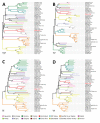Sand Fly-Associated Phlebovirus with Evidence of Neutralizing Antibodies in Humans, Kenya
- PMID: 30882303
- PMCID: PMC6433041
- DOI: 10.3201/eid2504.180750
Sand Fly-Associated Phlebovirus with Evidence of Neutralizing Antibodies in Humans, Kenya
Abstract
We describe a novel virus, designated Ntepes virus (NPV), isolated from sand flies in Kenya. NPV has the characteristic phlebovirus trisegmented genome architecture and is related to, but distinct from, Gabek Forest phlebovirus. Diverse cell cultures derived from wildlife, livestock, and humans were susceptible to NPV, with pronounced permissiveness in swine and rodent cells. NPV infection of newborn mice caused rapid and fatal illness. Permissiveness for NPV replication in sand fly cells, but not mosquito cells, suggests a vector-specific adaptation. Specific neutralizing antibodies were found in 13.9% (26/187) of human serum samples taken at the site of isolation of NPV as well as a disparate site in northeastern Kenya, suggesting a wide distribution. We identify a novel human-infecting arbovirus and highlight the importance of rural areas in tropical Africa for arbovirus surveillance as well as extending arbovirus surveillance to include hematophagous arthropods other than mosquitoes.
Keywords: Gabek Forest phlebovirus; Kenya; Ntepes virus; arbovirus; neutralizing antibodies; phlebovirus; sand flies; virus discovery; viruses.
Figures





Similar articles
-
Detection of a Novel Phlebovirus (Drin Virus) from Sand Flies in Albania.Viruses. 2019 May 23;11(5):469. doi: 10.3390/v11050469. Viruses. 2019. PMID: 31126034 Free PMC article.
-
Serological Evidence of Phleboviruses in Domestic Animals on the Pre-Apennine Hills (Northern Italy).Viruses. 2021 Aug 10;13(8):1577. doi: 10.3390/v13081577. Viruses. 2021. PMID: 34452442 Free PMC article.
-
Characterization of the Punta Toro species complex (genus Phlebovirus, family Bunyaviridae).J Gen Virol. 2015 Aug;96(8):2079-2085. doi: 10.1099/vir.0.000170. Epub 2015 May 1. J Gen Virol. 2015. PMID: 25934793 Free PMC article.
-
Phlebotomine sand fly-borne pathogens in the Mediterranean Basin: Human leishmaniasis and phlebovirus infections.PLoS Negl Trop Dis. 2017 Aug 10;11(8):e0005660. doi: 10.1371/journal.pntd.0005660. eCollection 2017 Aug. PLoS Negl Trop Dis. 2017. PMID: 28796786 Free PMC article. Review.
-
Practical Guidelines for Studies on Sandfly-Borne Phleboviruses: Part II: Important Points to Consider for Fieldwork and Subsequent Virological Screening.Vector Borne Zoonotic Dis. 2017 Jan;17(1):81-90. doi: 10.1089/vbz.2016.1965. Vector Borne Zoonotic Dis. 2017. PMID: 28055572 Review.
Cited by
-
Characterization of a Novel Orbivirus from Cattle Reveals Active Circulation of a Previously Unknown and Pathogenic Orbivirus in Ruminants in Kenya.mSphere. 2023 Apr 20;8(2):e0048822. doi: 10.1128/msphere.00488-22. Epub 2023 Feb 16. mSphere. 2023. PMID: 36794933 Free PMC article.
-
Exploring the influence of different habitats and their volatile chemistry in modulating sand fly population structure in a leishmaniasis endemic foci, Kenya.PLoS Negl Trop Dis. 2021 Feb 1;15(2):e0009062. doi: 10.1371/journal.pntd.0009062. eCollection 2021 Feb. PLoS Negl Trop Dis. 2021. PMID: 33524028 Free PMC article.
-
Viral diversity and blood-feeding patterns of Afrotropical Culicoides biting midges (Diptera: Ceratopogonidae).Front Microbiol. 2024 Jan 5;14:1325473. doi: 10.3389/fmicb.2023.1325473. eCollection 2023. Front Microbiol. 2024. PMID: 38249470 Free PMC article.
-
Isolation and Growth Kinetics of Bogoria Virus from Phlebotomine Sandflies Sampled in Baringo, Kenya.Am J Trop Med Hyg. 2024 Jun 25;111(2):412-415. doi: 10.4269/ajtmh.24-0032. Print 2024 Aug 7. Am J Trop Med Hyg. 2024. PMID: 38917821 Free PMC article.
-
First report of Karimabad virus in Rhombomys opimus in China.One Health. 2022 Sep 29;15:100437. doi: 10.1016/j.onehlt.2022.100437. eCollection 2022 Dec. One Health. 2022. PMID: 36277086 Free PMC article.
References
Publication types
MeSH terms
Substances
LinkOut - more resources
Full Text Sources

